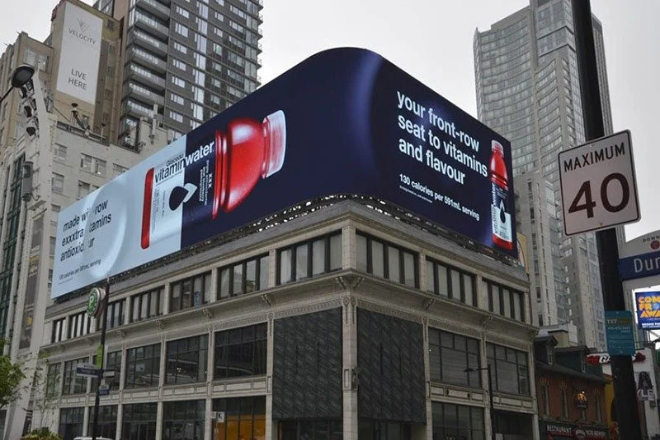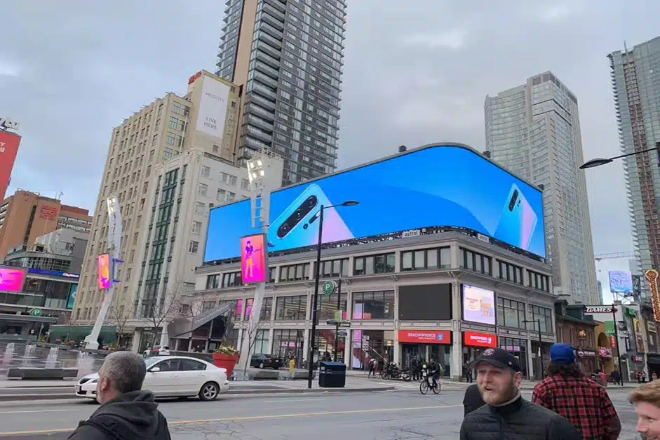介绍
Have you ever wondered why some LED显示屏 on the roof can shine and attract countless eyes, while some are unknown?
In fact, there is a lot of knowledge in this! Today, let us uncover the secrets of installing LED display screens on the roof and see what should be paid attention to when installing LED display screens on the roof.
目录
1. Can all LED display screens be installed on the roof?
If you want to install LED display screens on the roof, the screen cannot be too “heavy”, otherwise the roof can’t stand it.
It is best to choose the one made of aluminum alloy or carbon fiber, which is light and strong.
The roof is exposed to wind and rain, and the display screen must be able to withstand it.
None of these functions such as waterproof, dustproof, and UV protection can be missing, otherwise it will break down in a short time.
In addition, the wind on the roof is strong, and the screen must have a “windproof” design, such as tilting it to reduce wind resistance.
Otherwise, the screen will sway when the wind blows, which is too dangerous.
The situation on the roof is quite special. First of all, we have to see if the roof can bear the weight of the display screen. If the load-bearing capacity is not enough, it will not work.
Waterproofing is also very important. Installing the display screen may damage the waterproof layer of the roof. It will be troublesome if rainwater leaks in. Waterproofing measures must be taken.
In addition, the roof is easily struck by lightning, so lightning protection devices must be available.
Otherwise, the screen will be scrapped once the lightning strikes. In addition, the light of the display screen should not be too dazzling.
If it affects the surrounding residents or the flight of the aircraft, it will be troublesome. The brightness and angle must be controlled.
When installing a display screen on the roof, the supporting structure is very important. You must use a strong steel frame, otherwise the screen will not stand steadily.
The installation method is also particular, such as column type, wall-mounted or embedded, and it must be selected according to the specific situation of the roof.
Moreover, the screen must be easy to repair. If it is broken, the broken parts can be quickly replaced. Otherwise, it will take a lot of effort to repair it every time.
It is not easy to install a display screen on the roof. You must first apply for a license from the relevant department and clearly state the installation plan, screen parameters, and safety measures.
The rules are different in each place. Some places have requirements for 亮度, installation location, and display screen use time.
You must follow the rules; otherwise, you may be fined. After installation, you must check regularly to ensure that everything is normal.
In short, not all LED displays are suitable for installation on the roof. You must consider the performance of the screen itself, the environment of the roof, the installation method, and laws and regulations.
2. Under what circumstances is it recommended to use a rooftop installation?

1). 户外广告展示
Imagine that you are standing on the streets of the city, surrounded by high-rise buildings and billboards everywhere. But if there is a huge LED display hanging high on the roof, it will definitely catch your eye instantly!
The LED display screen installed on the roof is like standing on the shoulders of giants, allowing your advertising content to be seen by more people.
For example, near a commercial center or a busy street, the LED display on the roof can easily attract pedestrians and drivers on the road, and the advertising effect is directly maximized.
Moreover, this installation method is particularly suitable for those businesses that want to “brush their presence” in the city. For example, some large shopping malls and chain brands.
A store that is doing promotional activities puts the advertisement on the roof, which can be seen within a radius of several kilometers, and the effect is not comparable to ordinary billboards.
2). The building is high
If the building itself is very high, or it is a particularly distinctive landmark building, then the top-floor LED display is simply the icing on the cake.
For example, those super high-rise office buildings, five-star 酒店, or iconic buildings in city squares, the display on the roof can not only display advertisements, but also become part of the city’s night view, making the building more technological and modern.
Moreover, this installation method can also take advantage of the height of the building so that the display can be seen from farther away.
For example, in high-rise buildings near airports or highways, the LED display on the roof can be seen by drivers in the distance, and information can be delivered in advance, such as flight information, road condition reminders, or advertising.
The environment on the roof is quite special. The sunlight is very strong during the day, and there may be a lot of light interference around at night.
Therefore, the LED display screens installed on the roof are usually high-brightness and high contrast, and the angle can be adjusted to ensure that the content can be clearly seen from different directions.
This type of display screen is particularly suitable for scenes that need to display high-definition videos, pictures, or dynamic content outdoors.
For example, when holding large-scale events, you can play trailers or highlights of the event on the roof to attract people from afar.
During sports events, live broadcasts of the event can be played so that people around can feel the atmosphere of the scene.
4). Limited space but limited budget
Sometimes, the space on the roof may not be large, or your budget is not enough to install a particularly complex and large display screen.
At this time, the rooftop installation is very “economical.” It does not need to take up too much space like ground installation, nor does it require a complex support structure, and the cost is relatively lower.
For example, some small commercial buildings or office buildings have limited roof space, but they want to do some advertising. A small but high-brightness LED display installed on the rooftop can save space and achieve the effect of publicity with a high cost-effectiveness.
5). City landmarks or special buildings
Now, many cities are creating night view projects to make the city more beautiful at night. The LED display installed on the rooftop can become part of the city night view together with the lights of the building.
For example, in some tourist cities, LED displays are installed on the roofs of hotels or commercial centers to play some videos or pictures related to local culture and tourism, which can not only attract tourists’ attention, but also enhance the image of the city.
Moreover, this display can also adjust the content according to different festivals or activities, such as playing Spring Festival-themed animations during the Spring Festival and playing National Day-themed videos during the National Day, making the rooftop display a “dynamic business card” of the city.
In short, the rooftop installation of LED displays is particularly suitable for those who want to “shine” outdoors, such as advertising, landmark building displays, large-scale event live broadcasts, or creating city night views.
As long as the building is high enough and the location is good, this installation method will definitely make your display the focus.
3. What are the preparations before installing the LED display on the roof?
1). On-site survey and evaluation
Before starting the installation, you have to go to the roof to take a good look. This step cannot be sloppy.
On-site survey is to find out the “family background” of the roof to see if the display screen can be installed and how to install it.
1.1). Roof structure:
First, you have to see if the “skeleton” of the roof is strong enough.
Whether the roof can bear the weight of the display screen is a big problem. If the roof itself is not strong enough, it will be dangerous to install the display screen.
You also have to check the waterproof condition of the roof. After all, installing the display screen may damage the waterproof layer.
If the waterproofing is not done well, the building may be “flooded” on rainy days in the future.
1.2). Space layout:
You have to measure how much space is on the roof to see where the display screen is suitable.
You have to consider which direction the display screen is facing and where it is best to see it. If the display screen is not installed in a good position, it will either be invisible to others or affect the normal use of other facilities on the roof.
1.3). Power access point:
You have to find out the power supply situation on the roof and see if the capacity of the transformer is sufficient. The display screen is not a small appliance, and its power is not small.
If the transformer cannot carry it, the display screen will “go on strike”. It is also necessary to determine how to connect the power line and which route is the most reasonable.
1.4). Surrounding environment:
See whether the display screen will affect the surrounding environment after it is installed, such as whether light pollution will affect the lives of surrounding residents or whether it will block other people’s sight.
At the same time, it is necessary to see if there are strong electromagnetic interference sources around, which may affect the signal transmission of the display screen.
2). According to the results of the on-site investigation, you can start to formulate an installation plan:
2.1). Installation location:
Choose a place with a wide field of view that does not affect other functions of the building when installing the display screen.
If the location is not chosen well, no one can see the effect of the display screen, no matter how good it is.
2.2). Support structure design:
Design a stable support structure according to the weight and size of the display screen. This is the “backbone” of the display screen.
If the support structure is not strong, the display screen will be in danger when encountering strong winds.
2.3). Power wiring planning:
Plan the route of power lines and signal lines to ensure the safety of the lines and to make them as beautiful as possible. Don’t let a bunch of wires be messy.
3). Design and planning
Preparation work is not just a matter of looking at the site. You also need to design and plan it well. After all, this is a technical job.
3.1). Structural design:
- Steel structure strength:
The steel structure supporting the display must be strong enough to bear the weight of the display and resist external forces such as wind.
If the structure is not strong, the display may fall at any time, which will be a big trouble.
- Connection method:
Use welding or bolting to connect the steel structure to ensure that the structure is firm. If the connection is not firm, the display may shake when there is a little disturbance.
- 抗震设计:
Considering the situation of natural disasters such as earthquakes, the supporting structure must also have earthquake resistance.
Although earthquakes are not common, if they really happen, the display cannot be easily damaged.
3.2). Power system design:
- Transformer capacity:
Choose a transformer of appropriate capacity according to the power of the display screen.
If the transformer is too small, the display screen may not be able to “eat enough” and operate abnormally; if it is too large, it will waste resources.
- Cable selection:
Choose appropriate cables to ensure stable and safe power transmission. Poor cable quality or inappropriate specifications may lead to unstable power transmission and even cause safety accidents.
- Distribution cabinet design:
Design a reasonable distribution cabinet to facilitate future management and maintenance.
The distribution cabinet is like the “energy control center” of the display screen. If the design is unreasonable, it will be troublesome to maintain it in the future.
3.3). Signal transmission design:
- Fiber optic transmission:
If the display screen is far away from the control device, it is best to use a fiber optic transmission signal.
The fiber optic transmission signal is stable, and the transmission distance is long, which ensures that the display screen displays content normally.
- Wireless transmission:
In some special cases, wireless transmission signals can also be considered.
However, the stability and security of wireless transmission signals are worse than those of optical fibers, so they must be carefully considered.
4). Legal and compliant installation:
The importance of legal and compliant installation must be emphasized. If you install without a permit, you may not only face legal risks but also be fined or even forced to remove the display.
Therefore, during the installation process, you must strictly abide by relevant laws and regulations and act in accordance with the regulations to avoid unnecessary trouble.
4. What are the key links in the installation process?

1). Foundation construction and support structure construction
1.1). Key points of rooftop foundation construction
- Ensure a solid foundation:
The foundation is the “foundation” of the entire display and must be strong enough. When constructing on the roof, you must first clean the installation area to ensure that there are no debris and loose parts.
The foundation is usually poured with concrete. During the pouring process, the proportion and vibration quality of the concrete must be strictly controlled to ensure that the foundation is dense and free of voids.
- Foundation flatness:
The foundation surface must be flat, and the error must be controlled at the millimeter level.
If the foundation is not flat, the display may tilt or be loose after installation, affecting the display effect.
- Connection with the building structure:
The foundation must be reliably connected to the building structure on the roof, usually using embedded parts or expansion bolts.
Embedded parts should be accurately installed in the foundation in advance to ensure that their position and strength meet the requirements.
Expansion bolts should be selected with appropriate specifications, and pull-out tests should be carried out after installation to ensure their firmness.
1.2). Support structure construction
- Steel structure construction process:
When building the support structure, it must be carried out strictly in accordance with the design drawings.
First, prepare all the required steel materials and check whether their quality meets the requirements.
Then, cut and process according to the designed dimensions, with high processing accuracy and error within the allowable range.
- 焊接质量:
焊接是钢结构施工中的关键环节,焊接质量直接影响支撑结构的牢固性。
焊工必须持证上岗,焊接时必须严格按照焊接工艺操作,保证焊缝饱满,无气孔、无夹渣。
焊接完成后,应进行外观检查和无损检测,以确保焊缝质量。
- 防腐处理:
屋顶环境恶劣,钢结构易受腐蚀,因此,施工完成后,必须对钢结构进行防腐处理。
通常采用热镀锌或喷涂防腐漆,以保证钢结构在长期使用过程中不会生锈。
- 安装精度:
支撑结构的安装精度也非常重要,安装过程中应采用经纬仪、水平仪等专业测量工具,确保钢结构的垂直度、水平度、平整度符合要求。
安装完成后,应进行整体检查和调整,确保支撑结构的稳定性和可靠性。
2).安全防护措施
2.1). 高空作业安全
- 安全带:
在楼顶安装显示屏时,高空作业人员必须佩戴安全带,安全带应正确佩戴并系在牢固的固定点,以确保在发生事故时能够保护人员的安全。
- 安全网:
施工区域下方应设置安全网,防止人员和物品坠落。应定期检查安全网,确保其完好无损。
- 脚手架:
搭建脚手架时,应严格按照规范进行,确保脚手架的稳固性和安全性。
脚手架搭建应牢固可靠,脚手板应铺满、牢固,防止人踩空。
2.2).防雷与接地
- 防雷接地设计要点:
屋顶环境容易遭受雷击,因此显示屏的防雷接地设计非常重要。
防雷接地系统应包括避雷针、避雷带、接地装置等。
应在显示屏的最高点安装避雷针,沿显示屏边缘布置避雷带,接地装置应选择合适的接地电阻,以保证接地系统的可靠性和有效性。
- 确保接地系统的可靠性和有效性:
接地系统安装完毕后,应进行接地电阻测试,确保接地电阻符合要求。
应定期对接地装置进行检查和维护,防止接地装置损坏或接地电阻增大。
在雷雨季节,应特别注意防雷接地系统的检查和维护,确保其正常运行。
5. 结论
看完这些,你是不是觉得在楼顶安装LED显示屏其实是个技术活?别小看那些高楼大屏幕,它们都是经过精心设计、严格要求的!
最后,如果你想了解更多关于LED显示屏的信息, 请与我们联系。
